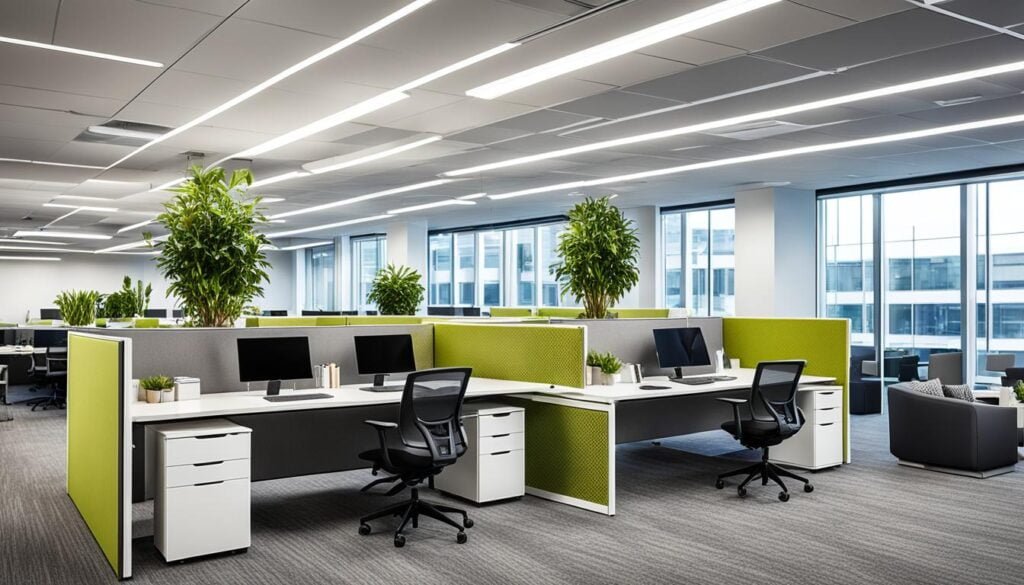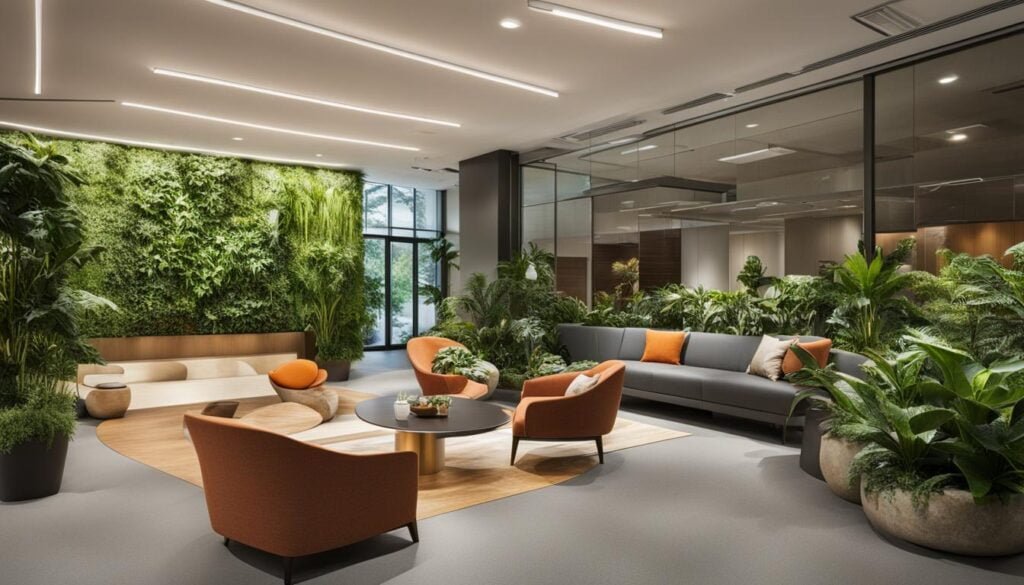Welcome to our article on workplace wellness design, where we explore the key elements of creating healthier office environments that prioritize employee well-being and productivity. In today’s fast-paced work culture, it has become essential for organizations to foster a workplace that promotes health, happiness, and success.
Workplace wellness design encompasses various factors that contribute to a healthy office environment. From optimizing indoor air quality to creating acoustic comfort, from incorporating natural light to implementing wellness programs, each element plays a crucial role in enhancing employee well-being and productivity.
Key Takeaways:
- Workplace wellness design focuses on creating healthier office environments.
- Key factors include indoor air quality, acoustic comfort, natural light, and wellness programs.
- Optimizing these elements can boost employee well-being and productivity.
- Investing in workplace wellness design fosters a culture of health and success.
- Partnering with experts like Global Healthcare Resources can support the implementation of workplace wellness strategies.
Indoor Air Quality: Optimizing Productivity and Cognitive Function
Indoor air quality is a critical factor in creating a healthy office environment that promotes employee well-being and productivity. By ensuring clean and fresh air, organizations can optimize their workforce’s cognitive function and overall performance.
Poor indoor air quality can lead to various health issues, including allergies and respiratory problems, which can hinder employees’ ability to focus and perform at their best. According to research studies, improved ventilation rates in offices have been shown to reduce staff sick days by up to 35%. Investing in indoor air quality not only creates a healthier workspace but also has a direct impact on employee well-being and productivity.
Various organizations, such as WELL Certified, FITWEL, and RESET AIR, have defined healthy building standards for indoor air quality. These standards provide guidelines and best practices for maintaining optimal indoor air quality, including proper ventilation, air filtration, and control of pollutants.
By adhering to these guidelines and implementing strategies to improve indoor air quality, organizations can create an environment that fosters productivity, cognitive function, and overall employee satisfaction.
The Impact of Indoor Air Quality on Productivity and Cognitive Function
High-quality indoor air can have a significant impact on employees’ ability to think clearly, make sound decisions, and perform complex tasks. Here are some key ways in which indoor air quality optimization can enhance productivity and cognitive function:
- Reduced Allergens: Clean and filtered air reduces the presence of allergens such as dust mites, pollen, and mold, minimizing the risk of allergies and allergic reactions. This allows employees to focus on their work without the distractions caused by allergy symptoms.
- Improved Respiratory Function: Good air quality helps maintain healthy respiratory systems, enabling employees to breathe easily without experiencing respiratory issues. This improves oxygen intake, which is essential for cognitive function and overall alertness.
- Enhanced Concentration: Fresh air promotes mental clarity and concentration, allowing employees to stay focused on their tasks for longer periods. By reducing mental fatigue, employees can maintain a higher level of productivity throughout the workday.
- Optimized Brain Function: Clean air improves brain function by delivering sufficient oxygen to the brain. This enhances memory, learning, and overall cognitive performance, enabling employees to process information more effectively.
- Reduced Stress and Fatigue: Breathing in clean air has a calming effect on the body and mind, reducing stress levels and preventing the onset of mental and physical fatigue. This leads to improved job satisfaction and overall well-being.
Implementing Strategies for Improving Indoor Air Quality
To optimize indoor air quality and reap the benefits of improved productivity and cognitive function, organizations can take the following steps:
- Ensure proper ventilation systems are in place to circulate fresh air and remove pollutants effectively.
- Regularly inspect and clean HVAC systems, air filters, and air ducts to prevent the buildup of dust, allergens, and contaminants.
- Use air purifiers and filtration systems to remove airborne pollutants and improve air quality in enclosed spaces.
- Implement a green cleaning program that utilizes environmentally friendly cleaning products to reduce the introduction of harmful chemicals into the office environment.
- Encourage employees to keep indoor plants, which can naturally purify the air and improve overall indoor air quality.
- Provide adequate outdoor breaks for employees to breathe in fresh air and recharge.
Optimizing indoor air quality is an investment in employee well-being and productivity. By creating a clean and healthy work environment, organizations can foster a positive workplace culture that prioritizes the cognitive function and overall success of their employees.
Workplace wellness design Acoustic Comfort Reducing Noise-Related Stress
Acoustic comfort is an often overlooked aspect of office design that plays a crucial role in employees’ mental health and productivity. The constant buzz of conversations, ringing phones, and other noise distractions can significantly impact concentration, leading to headaches, distractions, and increased stress levels.
Creating a quiet workspace with the right amount of ambient background sound is essential to promote health and productivity. By incorporating acoustic strategies in interior design, such as isolating HVAC equipment, using acoustic flooring, and implementing noise control measures, employers can significantly enhance acoustic comfort and reduce noise-related stress for their employees.
Studies have indicated that employees working in open-plan offices with a quieter environment reported higher levels of fatigue and less motivation to continue working. On the other hand, providing a noise-free zone can lead to improved focus, increased job satisfaction, and overall well-being.
Investing in acoustic comfort not only demonstrates a commitment to employee welfare but also has a direct positive impact on productivity. By reducing noise-related stress, companies can create a calm and conducive work environment, allowing employees to thrive and reach their full potential.
Benefits of Acoustic Comfort in the Workplace:
- Enhanced concentration and focus
- Reduced stress levels
- Improved productivity and efficiency
- Increased job satisfaction
- Reduced absenteeism and staff turnover
Acoustic Control Strategies:
Employers can implement various acoustic control strategies to create a more comfortable and productive work environment:
- Isolation: Invest in high-quality acoustic materials to isolate noise sources like HVAC equipment or office machinery.
- Flooring: Use acoustic flooring materials that absorb sound and reduce noise transmission between floors.
- Noise Control Measures: Install soundproof partitions, acoustic panels, and ceiling baffles to absorb and dampen noise within the office space.
- Designated Quiet Areas: Create designated quiet areas where employees can escape the noise and find a peaceful space for deep concentration.
By prioritizing acoustic comfort in workplace design, employers can take significant steps towards reducing noise-related stress and promoting a healthier and more productive work environment.
Designing for Holistic Well-being Ergonomics, Natural Light, and Wellness Programs
In today’s workplace, designing for holistic well-being is a top priority. Beyond optimizing air quality and acoustic comfort, incorporating elements such as ergonomics, natural light, and wellness programs can significantly enhance employee health and productivity. Let’s explore how these factors contribute to creating a healthier and happier office environment.
Ergonomics: Prioritizing ergonomics in office design plays a crucial role in reducing the risk of musculoskeletal disorders and improving productivity. By providing adjustable chairs, ergonomic desks, and proper keyboard and monitor placement, employers can help employees maintain good posture and reduce the strain on their bodies. This not only promotes physical well-being but also enhances focus and overall job performance.
Natural Light: Incorporating natural light into the workspace has numerous benefits for employee well-being. Exposure to natural light improves mood, increases vitamin D levels, and regulates circadian rhythms, leading to better sleep patterns and enhanced productivity. Designing offices with large windows, skylights, or implementing daylighting strategies can create a vibrant and inspiring work environment.
“Natural light has a profound effect on our well-being, both physically and mentally. It has been shown to reduce stress levels, increase productivity, and positively impact overall health.”
– Dr. Sarah Quinn, Neuroscientist
Noise Control: To create a conducive work environment, noise control measures are essential. Acoustic panels, partitions, and sound-absorbing materials can significantly reduce distracting noises and create a quiet workspace. By minimizing noise-related distractions, employees can focus better, experience less stress, and achieve optimal productivity.
Wellness Programs: Integrating wellness programs into the workplace is an effective way to promote employee health and well-being. From fitness classes to stress management workshops and nutrition counseling, these programs offer valuable resources and support for employees to lead a healthy lifestyle. Additionally, break areas and remote work flexibility provide opportunities for work-life balance, further enhancing holistic well-being.
The Impact of Holistic Well-being Design
Designing for holistic well-being not only creates a healthier office environment but also brings numerous benefits to both employees and organizations. By prioritizing ergonomics, natural light, and wellness programs, employers can:
- Improve employee health, reducing absenteeism and health-related costs
- Increase employee engagement and job satisfaction
- Enhance productivity and performance
- Promote a positive work culture and attract top talent
- Reduce stress and burnout
Investing in holistic well-being design is a strategic decision that fosters a supportive and thriving workplace environment. By prioritizing the physical and mental health of employees, organizations can unlock their full potential and achieve long-term success.
| Benefits of Designing for Holistic Well-being | Ergonomics | Natural Light | Noise Control | Wellness Programs |
|---|---|---|---|---|
| Improved employee health | Reduces the risk of musculoskeletal disorders | Increases vitamin D levels | Reduces stress levels | Supports a healthy lifestyle |
| Increased productivity | Enhances focus and job performance | Regulates circadian rhythms | Minimizes noise-related distractions | Promotes work-life balance |
| Enhanced employee engagement and satisfaction | Improves employee well-being | Creates an inspiring work environment | Fosters a quiet workspace | Reduces stress and burnout |
By considering the holistic well-being of employees, organizations can create office environments that prioritize health, happiness, and success.
Conclusion
Foster a culture of Workplace wellness design by implementing design strategies that prioritize employee health and well-being. Workplace wellness design enhances productivity, reduces stress, and promotes a healthier office environment. Optimizing indoor air quality, creating acoustic comfort, designing for holistic well-being, and incorporating wellness programs are key elements of workplace wellness design.
By partnering with experts like Global Healthcare Resources, organizations can take proactive steps towards creating healthier office environments and nurturing a more prosperous and fulfilled workforce. Embrace workplace wellness design to transform your office into a space that promotes health, happiness, and success.
FAQ
How does workplace wellness design contribute to creating healthier office environments?
Workplace wellness design prioritizes employee well-being and productivity by optimizing factors such as indoor air quality, acoustic comfort, biophilic design, thermal comfort, and physical well-being.
What is the importance of indoor air quality in a healthy office environment?
Indoor air quality plays a vital role in shaping a healthy office environment by reducing the risk of allergies and respiratory problems, optimizing productivity, and improving cognitive function among employees.
How can organizations enhance acoustic comfort in the office?
Organizations can enhance acoustic comfort in the office by incorporating acoustic strategies in interior design, such as isolating HVAC equipment, using acoustic flooring, and implementing noise control measures.
What are the key elements of designing for holistic well-being in the workplace?
Designing for holistic well-being includes incorporating elements such as ergonomic furniture, natural light, noise control measures, wellness programs, break areas, and remote work flexibility to promote physical and mental health among employees.
How can workplace wellness design improve productivity and reduce stress?
Workplace wellness design enhances productivity and reduces stress by optimizing factors that prioritize employee health and well-being, creating a healthier office environment that fosters a culture of wellness.












